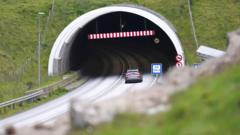In 2023, India recorded over 480,000 road accidents, resulting in more than 172,000 fatalities, revealing a dire road safety crisis driven by human behavior and infrastructure failures.**
Fatalities on Indian Roads: A Deep Dive into a National Crisis**

Fatalities on Indian Roads: A Deep Dive into a National Crisis**
India's alarming road accident statistics highlight an urgent need for comprehensive safety reforms and infrastructure improvement.**
In 2023, road safety in India reached crisis levels, as statistics indicated over 480,000 accidents claimed over 172,000 lives. This grim reality reflects a profound national concern where the average fatality rate stood at nearly one person every three minutes. Amidst an array of newspaper headlines detailing tragic incidents, from passenger buses going off cliffs to reckless drivers injuring innocent pedestrians, the urgency of addressing road safety in India has never been clearer.
While the official accident report for the year remains unpublished, Road Transport and Highways Minister Nitin Gadkari highlighted these figures during a road safety event in December. Among those who lost their lives, a heartbreaking 10,000 were children, with accidents near educational institutions contributing to another 10,000 deaths. Pedestrians, particularly vulnerable two-wheeler riders, were disproportionately affected. Common causes of these accidents included excessive speeding, a lack of safety measures—where 54,000 individuals died not wearing helmets and 16,000 due to neglecting seatbelts—and driving without valid licenses, linked to 34,000 incidents.
The chaotic mix of traffic on Indian roads exacerbates the problem, where motorized vehicles compete with bicycles, rickshaws, and pedestrians. Though significant investments have been made, India’s roads remain perilous. Experts attribute the high accident rates to a combination of flawed infrastructure, insufficient law enforcement, and behavioral issues among drivers.
With the world's second-largest road network, covering 6.6 million kilometers, only 5% consists of national and state highways, with the remaining roads often poorly maintained. Gadkari pointed out the underlying problems surrounding civil engineering practices, citing inadequate signage and poor management as crucial factors. Alarmingly, recent reports identified 59 critical deficiencies in highways, while numerous accident-prone areas remain untreated.
Rigorous audits conducted by the Transportation Research and Injury Prevention Centre (TRIPP) have exposed significant flaws in India's road infrastructure. For example, improperly installed crash barriers, which should mitigate vehicle accidents, are currently causing more dangers. Similarly, many raised medians are inadequately designed, risking high-speed crashes.
Despite possessing solid road design standards, enforcement remains lax. Minimal penalties for non-compliance contribute to a disregard for safety protocols. Minister Gadkari's recent initiative to upgrade two-lane highways to four lanes is met with skepticism. Experts argue that merely widening roads may amplify speed-related fatalities without addressing the underlying safety concerns unique to India’s traffic situation.
To combat the ongoing road safety issue, government officials intend to implement the "5Es" strategy—engineering, education, enforcement, and emergency care. Research indicates that better emergency medical responses could potentially halve road crash fatalities. With concentrated efforts in specifically identified accident-prone areas yielding positive results, experts advocate for a holistic approach to road management, aligning development with the safety of all road users.
As discussions regarding road infrastructure continue, many urge that the focus should remain on sustainability and prevention. While economic growth through infrastructure is vital, it should not come at the expense of pedestrian and cyclist safety. The way forward calls for iterative interventions in road design and thorough evaluations to ensure that measures taken effectively enhance the safety of Indian roads and protect its most vulnerable citizens.


















